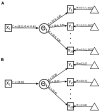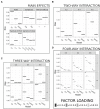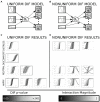The multiple indicator multiple cause model for cognitive neuroscience: An analytic tool which emphasizes the behavior in brain-behavior relationships
- PMID: 35992482
- PMCID: PMC9389455
- DOI: 10.3389/fpsyg.2022.943613
The multiple indicator multiple cause model for cognitive neuroscience: An analytic tool which emphasizes the behavior in brain-behavior relationships
Abstract
Cognitive neuroscience has inspired a number of methodological advances to extract the highest signal-to-noise ratio from neuroimaging data. Popular techniques used to summarize behavioral data include sum-scores and item response theory (IRT). While these techniques can be useful when applied appropriately, item dimensionality and the quality of information are often left unexplored allowing poor performing items to be included in an itemset. The purpose of this study is to highlight how the application of two-stage approaches introduces parameter bias, differential item functioning (DIF) can manifest in cognitive neuroscience data and how techniques such as the multiple indicator multiple cause (MIMIC) model can identify and remove items with DIF and model these data with greater sensitivity for brain-behavior relationships. This was performed using a simulation and an empirical study. The simulation explores parameter bias across two separate techniques used to summarize behavioral data: sum-scores and IRT and formative relationships with those estimated from a MIMIC model. In an empirical study participants performed an emotional identification task while concurrent electroencephalogram data were acquired across 384 trials. Participants were asked to identify the emotion presented by a static face of a child across four categories: happy, neutral, discomfort, and distress. The primary outcomes of interest were P200 event-related potential (ERP) amplitude and latency within each emotion category. Instances of DIF related to correct emotion identification were explored with respect to an individual's neurophysiology; specifically an item's difficulty and discrimination were explored with respect to an individual's average P200 amplitude and latency using a MIMIC model. The MIMIC model's sensitivity was then compared to popular two-stage approaches for cognitive performance summary scores, including sum-scores and an IRT model framework and then regressing these onto the ERP characteristics. Here sensitivity refers to the magnitude and significance of coefficients relating the brain to these behavioral outcomes. The first set of analyses displayed instances of DIF within all four emotions which were then removed from all further models. The next set of analyses compared the two-stage approaches with the MIMIC model. Only the MIMIC model identified any significant brain-behavior relationships. Taken together, these results indicate that item performance can be gleaned from subject-specific biomarkers, and that techniques such as the MIMIC model may be useful tools to derive complex item-level brain-behavior relationships.
Keywords: cognitive neurosciences; power; sensitivity; structural equation modeling; systems of equations.
Copyright © 2022 Rosen, Auger, Woodruff, Proverbio, Song, Ethridge and Bard.
Conflict of interest statement
The authors declare that the research was conducted in the absence of any commercial or financial relationships that could be construed as a potential conflict of interest.
Figures





References
-
- Benjamini Y., Hochberg Y. (1995). Controlling the false discovery rate: A practical and powerful approach to multiple testing. J. R. Stat. Soc., B: Stat. Methodol. 57, 289–300. doi: 10.1111/j.2517-6161.1995.tb02031.x - DOI
-
- Bollen K. A. (1989a). “Structural equation models with observed variables,” in Structural Equations With Latent Variables. (Wiley Online Books; ), 80–150.
LinkOut - more resources
Full Text Sources

